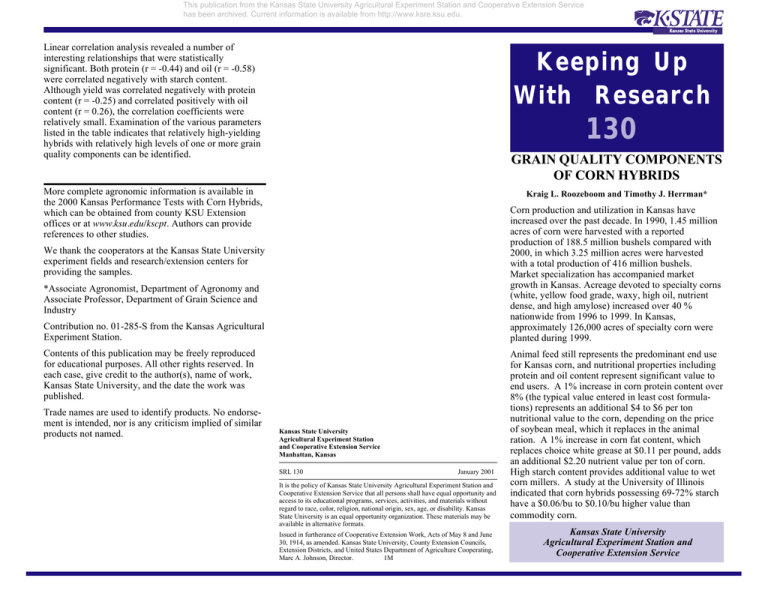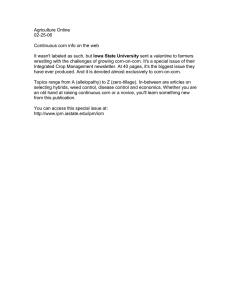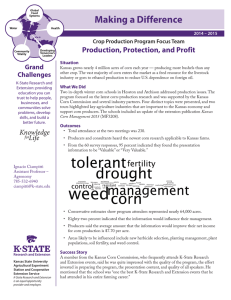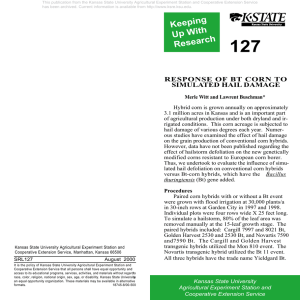
This publication from the Kansas State University Agricultural Experiment Station and Cooperative Extension Service
has been archived. Current information is available from http://www.ksre.ksu.edu.
Linear correlation analysis revealed a number of
interesting relationships that were statistically
significant. Both protein (r = -0.44) and oil (r = -0.58)
were correlated negatively with starch content.
Although yield was correlated negatively with protein
content (r = -0.25) and correlated positively with oil
content (r = 0.26), the correlation coefficients were
relatively small. Examination of the various parameters
listed in the table indicates that relatively high-yielding
hybrids with relatively high levels of one or more grain
quality components can be identified.
Keeping Up
With Research
130
GRAIN QUALITY COMPONENTS
OF CORN HYBRIDS
More complete agronomic information is available in
the 2000 Kansas Performance Tests with Corn Hybrids,
which can be obtained from county KSU Extension
offices or at www.ksu.edu/kscpt. Authors can provide
references to other studies.
Kraig L. Roozeboom and Timothy J. Herrman*
Corn production and utilization in Kansas have
increased over the past decade. In 1990, 1.45 million
acres of corn were harvested with a reported
production of 188.5 million bushels compared with
2000, in which 3.25 million acres were harvested
with a total production of 416 million bushels.
Market specialization has accompanied market
growth in Kansas. Acreage devoted to specialty corns
(white, yellow food grade, waxy, high oil, nutrient
dense, and high amylose) increased over 40 %
nationwide from 1996 to 1999. In Kansas,
approximately 126,000 acres of specialty corn were
planted during 1999.
We thank the cooperators at the Kansas State University
experiment fields and research/extension centers for
providing the samples.
*Associate Agronomist, Department of Agronomy and
Associate Professor, Department of Grain Science and
Industry
Contribution no. 01-285-S from the Kansas Agricultural
Experiment Station.
Contents of this publication may be freely reproduced
for educational purposes. All other rights reserved. In
each case, give credit to the author(s), name of work,
Kansas State University, and the date the work was
published.
Trade names are used to identify products. No endorsement is intended, nor is any criticism implied of similar
products not named.
Kansas State University
Agricultural Experiment Station
and Cooperative Extension Service
Manhattan, Kansas
SRL 130
January 2001
It is the policy of Kansas State University Agricultural Experiment Station and
Cooperative Extension Service that all persons shall have equal opportunity and
access to its educational programs, services, activities, and materials without
regard to race, color, religion, national origin, sex, age, or disability. Kansas
State University is an equal opportunity organization. These materials may be
available in alternative formats.
Issued in furtherance of Cooperative Extension Work, Acts of May 8 and June
30, 1914, as amended. Kansas State University, County Extension Councils,
Extension Districts, and United States Department of Agriculture Cooperating,
Marc A. Johnson, Director.
1M
Animal feed still represents the predominant end use
for Kansas corn, and nutritional properties including
protein and oil content represent significant value to
end users. A 1% increase in corn protein content over
8% (the typical value entered in least cost formulations) represents an additional $4 to $6 per ton
nutritional value to the corn, depending on the price
of soybean meal, which it replaces in the animal
ration. A 1% increase in corn fat content, which
replaces choice white grease at $0.11 per pound, adds
an additional $2.20 nutrient value per ton of corn.
High starch content provides additional value to wet
corn millers. A study at the University of Illinois
indicated that corn hybrids possessing 69-72% starch
have a $0.06/bu to $0.10/bu higher value than
commodity corn.
Kansas State University
Agricultural Experiment Station and
Procedures
Cooperative
Extension
Service in corn
Several factors
can contribute
to differences
This publication from the Kansas State University Agricultural Experiment Station and Cooperative Extension Service
has been archived. Current information is available from http://www.ksre.ksu.edu.
Procedures
Several factors can contribute to differences in corn
quality, including fertility, weather, and genetics. The
Kansas Crop Performance Tests provide an opportunity
to evaluate nutritional quality components of a large
number of corn hybrids at several locations. Grain
samples were obtained from 20 separate tests, 10 in
1997, 5 in 1999, and
5 in 2000: northeast—Severance, Powhattan,
Manhattan; east/southeast—Topeka (dryland and
irrigated), Ottawa, Erie; north central—Clay Center
(irrigated); northwest—Colby (dryland and irrigated),
Tribune (irrigated); and southwest—St. John (irrigated).
Corn yield, protein, oil, and starch components are
reported on a constant moisture basis. Quality
components were measured using a Foss Grainspec
(Foss North America, Eden Praire, IL) near-infrared
whole-grain analyzer.
Two hybrids that were present in every test were used as
checks: Pioneer 3162 and Golden Harvest H-2530. At
every location, each hybrid was compared to the
average of these two check hybrids. These differences
were averaged over the total number of tests where the
comparisons were made (N) and were used to calculate
the standardized values presented. Hybrids are listed in
order of decreasing protein percent because of the
importance of that component in livestock rations,
however, ranking by oil percent, starch percent, yield, or
maturity parameters may be just as appropriate for other
applications.
Results
Table 1 summarizes grain quality components and some
agronomic performance characters for hybrids that were
grown in five or more of the sampled tests. Yield, days
to half silk, and harvest moisture are included to provide
a summary of agronomic performance for comparison
purposes.
The corn hybrids displayed rather narrow ranges for the
various quality parameters (protein 1.7%, oil 0.7%,
starch 1.4%). However, the differences, especially for
protein, were large enough to have a potential economic
impact for livestock feeders.






